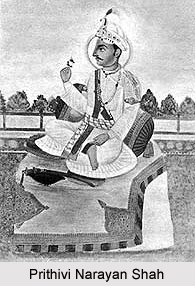 Pre-Bhanubhakta era in Nepali literature commences from its very source and beginning, moving up till the time period of 1871 A.D. Nepali literature during the pre-Bhanubhakta era verily and definitely had existed in oral and folklore forms for thousands of years. There however exists no evidence of an already issued literary work in Nepali language before Bhanubhakta (considered the first poet writing in Nepali language, who had translated the Ramayana from Sanskrit to Nepali). During this very ancient period of Nepali literature, the articles were almost always scripted upon the art of bravery and valorousness. As has been long established in the oft traversed path in Indian literature closely linked with Indian ancient history, literature written during primitive ages are mostly discovered as poetry. This is wholly applicable in cases of literatures in Nepali too. However, without the proper development of the prose, poetry could never have been possible in the written formats. Hence, prose also presents itself as dominant existence in the pre-Bhanubhakta era.
Pre-Bhanubhakta era in Nepali literature commences from its very source and beginning, moving up till the time period of 1871 A.D. Nepali literature during the pre-Bhanubhakta era verily and definitely had existed in oral and folklore forms for thousands of years. There however exists no evidence of an already issued literary work in Nepali language before Bhanubhakta (considered the first poet writing in Nepali language, who had translated the Ramayana from Sanskrit to Nepali). During this very ancient period of Nepali literature, the articles were almost always scripted upon the art of bravery and valorousness. As has been long established in the oft traversed path in Indian literature closely linked with Indian ancient history, literature written during primitive ages are mostly discovered as poetry. This is wholly applicable in cases of literatures in Nepali too. However, without the proper development of the prose, poetry could never have been possible in the written formats. Hence, prose also presents itself as dominant existence in the pre-Bhanubhakta era.
The most significant authors of pre-Bhanubhakta era in Nepali literature and their major works, which have augmented both the language and its readers, can be compiled as under:
Shuwananda Das: Shuwananda Das was a Newar (the indigenous people of Nepal`s Kathmandu Valley) by birth and had penned umpteen brilliant verses. His unmatched usage of the lyrical folksongs instead of the everyday Sanskrit tradition, had shot him into luminescent prominence in no time. Shuwananda Das was born in Lalitpur and was a resident of Nuga.
There exists three Shadhya ko kabi, considered a masterwork by this very prolific writer. Two of them are thought to have been written by him. The work encompasses a live presentation of the combat raged amongst bulls and their confromtations. The event is looked at as the emblem of victories of Gorkhali army . Shuwananda Das also had penned numerous poetries dedicated to and eulogising king Prithivi Narayan Shah`s fearlessness, victories, journey to Kasi etc.
Radha Ballav Arjyal: Radha Ballav Arjyal is unanimously deemed as a fine and sophisticated and refined poet of Nepali literature from pre-Bhanubhakta era . Out of the 3 Shadhya ko kabi, the legendary and over the top work in Nepali literature, one had been authored by him.
Prithivi Narayan Shah: Prithivi Narayan Shah has always been regarded as the founder of modern Nepal . In order to make his dream become transformed into reality, Narayan Shah had in an inimitable manner rendered literature in Nepali during the pre-Bhakubhakta era. He in fact did not strictly and rigorously write down in any book by his own pen but, the advices lent by him during the last phases of his life, were transmitted and given a fresh kind of life by his able successors in the written format .
The piece Divya Upedesh (1832) by Prithvi Narayan Shah is considered as the oldest original surviving prose ever to have been penned and documented in Nepali literature beginning in the pre-Bhabubhakta era. This luminous man had owned that much of capability of introducing the specialty of the long gone erstwhile age, that too with spellbinding imagination . In the cost of his long experiences, Prithvi Narayan Shah has furnished the fine instructions, which indeed display supreme honesty suitable to be applicable even to this day.
Shakti Ballav Arjyal: Shakti Ballav Arjyal was a scholar and an exceedingly polished writer , virtually penning both poems and prose single-handedly. He also had served as the royal priest of P.N. Shah`s palace and the brother of the legendary Radha Ballav Arjyal.
Shakti Ballav Arjyal is respected for his translation of Hanshyakaduba into Nepali literature of the pre-Bhabubhakta era. The said composition was originally spelt by Arjyal himself, but in Sanskrit language. Shakti Ballav Arjyal had authored Jayaratnakar natak (in Sanskrit), together with umpteen verses eulogising the ruler P.N. Shah .
Udaya Nanda Arjyal: Serving as the cousin of Shakti Ballav Arjyal, Udaya Nanda Arjayal also had scripted numerous poetries in praise of king P.N. Shah .
Pt. Divya Kasheri Arjyal (1847-1904) : Pt. Divya Kasheri Arjyal from pre-Bhabubhakta era in Nepali literature is acknowledged for scripting Goraksha Yog shastra.
Gumani Pant (1847-1904) : Gumani Pant was a resident of Almora (in Uttarakhand). When emperor P.N. Shah had won back Almora under his supremacy, Gumani Pant had begun to profusely pen about P.N. Shah`s bravery and fearlessness.
Indiras Bir Shali Panta : Indiras Bir Shali Panta is acknowledged as the author of Bimalbodhanuvaba
Bidhya Kasheri Arjyal (1863-1912) : Ugal Geet and Droupadi Stuti are the two works that Bidhya Kasheri Arjyal is credited with, during the pre-Bhabubhakta era in Nepali literature.



















